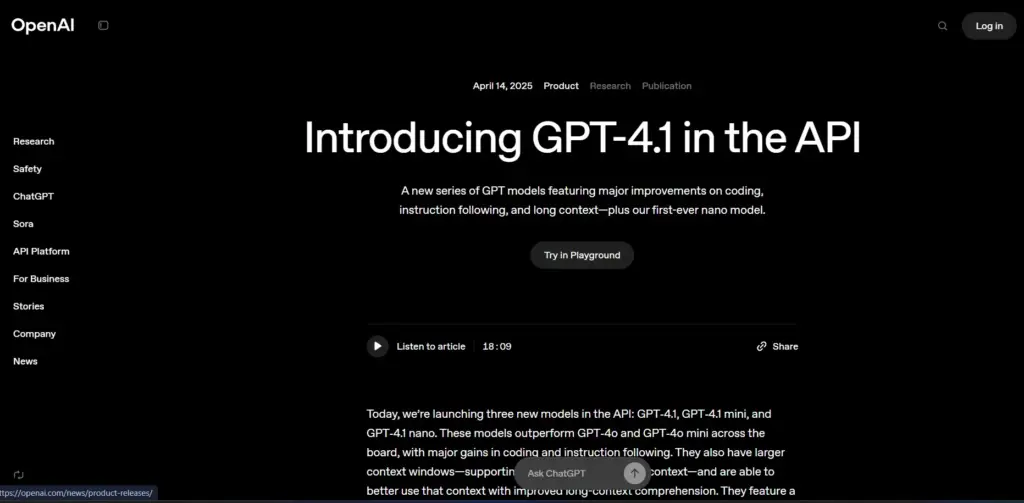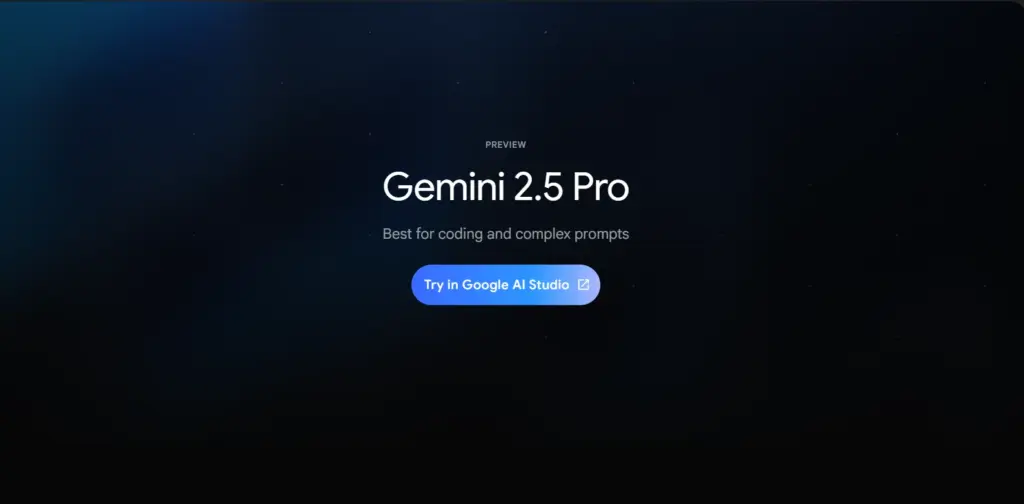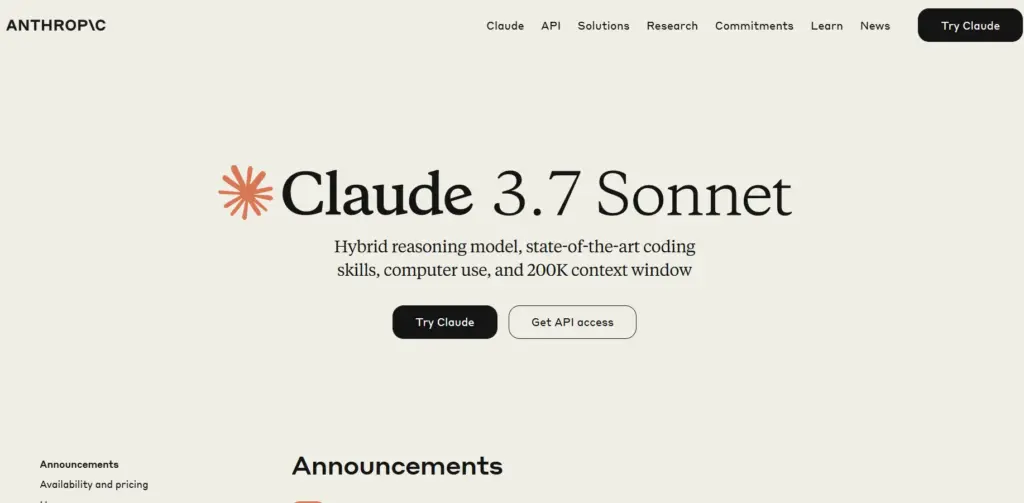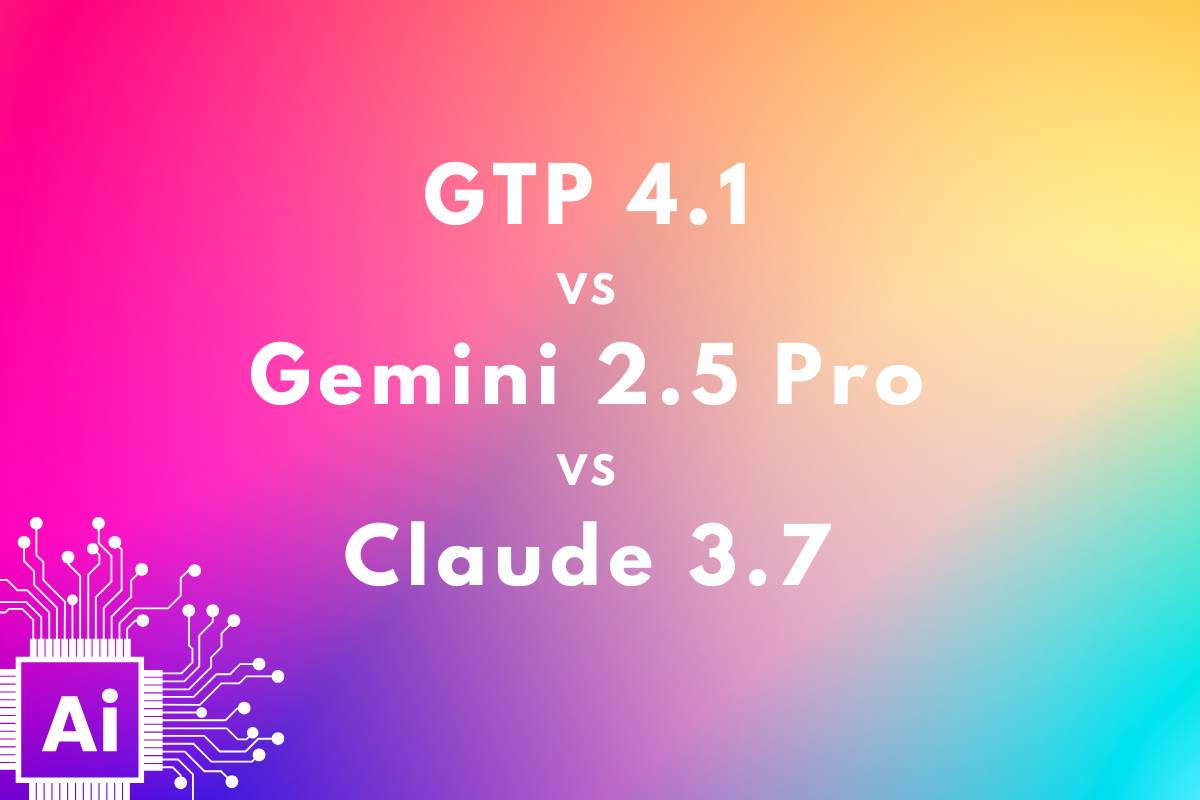In the fast-changing world of artificial intelligence, language models are continually breaking barriers on how machines can process, create, and accomplish things. For people exploring this changing world, it is important to know the differences among the top players. This article explores in-depth comparisons of three top AI models: OpenAI’s GPT-4.1, Google’s Gemini 2.5 Pro, and Anthropic’s Claude 3.7 Sonnet. By looking at their features, performance, and real-world uses, we hope to give you a clear picture of how these AI giants compare with one another so that you can decide which model best suits your particular needs.
Introducing the AI Giants:

GPT-4.1: Revealing the Powerhouse
GPT-4.1 is the newest development in OpenAI’s Generative Pre-trained Transformer (GPT) model series, furthering the work started by GPT-4o and other previous versions. This latest version brings major improvements, particularly in its capacity to perform coding tasks more competently, obey instructions more consistently, and process much more information due to its larger context window, which can now be up to 1 million tokens. OpenAI has also expanded its offerings in this line, adding GPT-4.1, GPT-4.1 mini, and GPT-4.1 nano. Each of these models is engineered to address varying computational needs and applications, giving users multiple choices depending on their particular needs for speed, expense, and performance. The release of a “nano” model indicates a strategic aim by OpenAI to offer AI solutions in an expanded spectrum of computational needs, ranging from demanding applications to more minimalistic uses. This nomenclature suggests a smaller, faster, and more cost-effective version, pointing towards an attempt to appeal to users with different latency and budget requirements.

Gemini 2.5 Pro: Google’s Next-Generation Reasoning Engine
Gemini 2.5 Pro is Google DeepMind’s latest artificial intelligence model to date, with a heavy focus on enhanced reasoning and coding ability.
One of the defining features of this model is its “thinking model” design. This architecture makes Gemini 2.5 Pro able to perform a process of deliberating and analyzing prompts before coming up with a response, which ultimately contributes to higher precision in its output. Additionally, Gemini 2.5 Pro is constructed using native multimodality, where it can smoothly comprehend and process information from any source, ranging from text and audio to images and video. The model further features a staggering context window of 1 million tokens, with plans to increase this capacity yet further in the future. Google’s emphasis on “reasoning” shows a clear intention to tackle more complex and subtle tasks that involve a higher level of understanding over and above mere pattern recognition within data. The consistent highlighting of its “thinking model” character and explanation of its capacity to analyze, conclude, and add context indicate a design to more closely mimic human thought processes.

Claude 3.7 Sonnet: Anthropic’s Hybrid Approach
Claude 3.7 Sonnet is Anthropic’s smartest model published to date, characterized by its groundbreaking “hybrid reasoning” framework. This special architecture enables Claude 3.7 Sonnet to alternate between giving quick answers for easier questions and taking a more thoughtful, step-by-step approach to complex issues through its “extended thinking” mode.
The model shows excellent coding and front-end web development capabilities, and Anthropic has also launched Claude Code, a command-line interface tool meant to enable agentic coding practices.
Claude 3.7 Sonnet also has a 200K token context window and has multimodal comprehension, which means it can handle both text and images. Anthropic’s work on “hybrid reasoning” and “extended thinking” indicates a design principle that emphasizes both speed and precision. This means users can tune the behavior of the model to suit the particular requirements of the task at hand. The explicit ability to transition between quick and thoughtful reasoning indicates a flexibility that could be particularly advantageous for a diverse range of applications with varying requirements.
GPT 4.1 vs Gemini 2.5 pro vs Claude 3.7: A Feature-by-Feature Comparison
Coding Prowess: Benchmarking Their Abilities.
When comparing the coding capabilities of GPT 4.1 vs Gemini 2.5 Pro vs Claude 3.7, benchmark results offer valuable insights.
The SWE-bench Verified benchmark, measuring how effectively models can repair actual coding problems, has Gemini 2.5 Pro taking first place with a score of 63.8%.
Claude 3.7 Sonnet is hot on its heels, scoring 62.3% on the base benchmark, and even hitting 70.3% with a custom scaffold.
GPT-4.1, although performing well, comes in last place in this particular benchmark with a score between 52% and 54.6%. Yet, GPT-4.1 is especially strong in other programming-related tasks. It illustrates better stability in code variation between different formats and performs better at front-end coding, where human evaluators chose websites produced by GPT-4.1 over GPT-4o 80% of the time.
Gemini 2.5 Pro has also been praised for producing complex working code in a single shot, like building a flight simulator or cracking a Rubik’s Cube. Claude 3.7 Sonnet also shines for efficiency in dealing with complex codebases and multi-step coding tasks, and Anthropic went on to roll out Claude Code, a capability specifically aimed at boosting its code generation further.
SWE-bench Verified Scores:
| Model | Score |
|---|---|
| GPT-4.1 | 52.0% - 54.6% |
| Gemini 2.5 Pro | 63.8% |
| Claude 3.7 Sonnet | 62.3% (70.3% with scaffold) |
Whereas Gemini 2.5 Pro and Claude 3.7 Sonnet show excellent all-around performance in coding tests, GPT-4.1’s front-end development and code diff-specific optimizations make it the likely go-to for developers with specific workflow needs. The comprehensive information on a range of coding tasks shows that the best model choice is contingent on the user’s specific coding requirements.
Reasoning and Problem-Solving: How They Stack Up.
Where reason and problem-solving are concerned, comparing GPT 4.1 vs Gemini 2.5 pro vs Claude 3.7 shows each of them with distinct strengths. Gemini 2.5 Pro usually excels at benchmarks measuring complex reasoning, for example, GPQA (expert-level graduate-level reasoning) and AIME (American Invitational Mathematics Examination).
It scored high on the Humanity’s Last Exam as well, a tricky benchmark for broad general knowledge and reasoning across broad areas.
Claude 3.7 Sonnet also has strong reasoning abilities, especially at the graduate level, expert reasoning, and its “extended thinking” mode enables it to perform a more detailed analysis for difficult problems.
This facility offers users some insight into the model’s thought process, which can be useful in gaining insight into how it develops solutions. GPT-4.1 has demonstrated better instruction following and multi-turn conversation handling, reflecting better reasoning in more interactive contexts.
Having a visible reasoning process available in Claude 3.7 Sonnet through its “extended thinking” mode provides a special benefit for users who must see the model’s problem-solving steps, which could make it useful for debugging complex outputs or for teaching purposes.
While Gemini 2.5 Pro seemingly has a slight edge in overall reasoning power based on benchmarks, Claude 3.7 Sonnet’s controlled reasoning capability offers a definite advantage for specific uses.
Context Window and Long-Term Memory.
Having the capability to process and remember information over longer interactions is essential for most applications, and the size of the context window matters. Regarding this aspect, GPT 4.1 vs Gemini 2.5 pro vs Claude 3.7. GPT-4.1 and Gemini 2.5 Pro both provide a stunning 1 million token context window. Such a large capacity enables these models to deal with extremely large documents, entire codebases, and very long conversations more easily.
Claude 3.7 Sonnet, though still proficient, possesses a relatively small context window of 200K tokens.
GPT-4.1 is specifically trained to access information across its entire 1 million token context reliably and does better than its predecessors in spotting relevant text amid long contexts.
Gemini 2.5 Pro has also performed well in benchmarks for evaluating long context understanding. The much wider context windows of Gemini 2.5 Pro and GPT-4.1 offer a huge boost for those tasks that need to handle huge quantities of data, which might make them ideal for enterprise-class usage or intense research. Processing entire code repositories or large documents within a single prompt can also dramatically simplify workflows and decrease the burden of prompt engineering.
Multimodal Capabilities: Managing Text, Images, and More.
The capacity to process and comprehend various forms of data, including images and text, is growing more significant. A comparison of multimodal strengths in GPT 4.1 vs Gemini 2.5 Pro vs Claude 3.7 sees Gemini 2.5 Pro leading the way with its in-built multimodality, encompassing text, audio, images, and video from the beginning.
All members of the Claude 3 family, such as 3.7 Sonnet, come with vision capabilities, through which they can analyze and process image data. Both text and image inputs are supported by GPT-4.1. Such multimodal capability enables a host of applications ranging from analyzing pictures and comprehending video content to processing documents with figures and graphs.
Gemini 2.5 Pro’s more extensive support for multiple modalities, such as audio and video, provides a clear edge in use cases that demand comprehension and processing of more varied types of data.
Support for video and audio natively may be especially useful for applications such as processing meeting recordings or interpreting the contents of video files.
Instruction Following and Real-World Utility
The effectiveness of an AI model is not just measured by benchmarks but also by its ability to accurately follow instructions and its practical utility in real-world scenarios. When comparing GPT 4.1 vs Gemini 2.5 pro vs Claude 3.7 in this aspect, GPT-4.1 has demonstrated significant improvements in instruction following evaluations. Gemini 2.5 Pro has demonstrated encouraging indications of grasping subtle prompts and is utilized in numerous applications.
Claude 3.7 Sonnet has excellent instruction following accuracy and is ideally suited to powering AI agents that must execute tasks according to certain guidelines. All three models have been useful in a wide range of real-world applications, such as code generation, data analysis, and content creation.
GPT-4.1’s particular emphasis on and reported gains in instruction following indicate that it could be especially valuable for use cases where strict compliance with intricate instructions is paramount. High-quality instruction following is needed to create solid and reliable AI applications.
Real-World Applications: Where Each Model Excels
Use Cases for GPT-4.1
GPT-4.1 shows special capability in software programming, so it is a useful tool for activities like code writing, debugging, and code checking. Its capacity to process long contexts makes it particularly suitable for processing lengthy legal documents or research papers. In addition, its enhanced instruction following and long context understanding make it extremely effective in constructing advanced AI agents.
Organizations such as Thomson Reuters have seen a 17% increase in accuracy when utilizing GPT-4.1 for the review of long legal documents, and Carlyle experienced a 50% increase in extracting information from intricate financial documents. This indicates that GPT-4.1 is strongly geared toward developer usage and enterprise applications that involve handling a lot of information.
Use Cases for Gemini 2.5 Pro
Gemini 2.5 Pro demonstrates its capabilities in producing interactive simulations, games, and engaging data visualizations.
Its powerful reasoning functions and large context window render it useful for research, coding, and examining large codebases. Its native multimodality enables applications in areas such as video and audio analysis.
Additionally, its integration with Google Workspace and other applications boosts productivity across different undertakings. The examples above illustrate its ability to process various types of data and generate complex results, which appeals to a wide range of applications.
Use Cases for Claude 3.7
Sonnet Claude 3.7 Sonnet excels in coding duties, especially in front-end programming and handling complex codebases.
Its strong reasoning capacity makes it worth considering for strategic planning and solving complex issues.
It is used in customer support, content writing, and data analysis.
The “extended thinking” mode is especially useful for solving complex problems and debugging.
Firms have been using Claude for tasks like customer service enhancement and automation of complex workflows. Its blend of speed and accuracy, and its solid coding capabilities, make it a jack-of-all-trades model for a broad spectrum of professional requirements.
API Access and Pricing: Knowing the Investment
GPT-4.1 API Cost and Availability
GPT-4.1 is now available only through the API, mainly targeted at developers. OpenAI charges a tiered pricing plan for the GPT-4.1 family.
GPT-4.1 is priced at $2.00 per 1 million input tokens and $8.00 per 1 million output tokens, with discounts available for cached inputs and batch API usage. The mini and nano variants offer more affordable options for users with different performance and cost sensitivities. OpenAI has also decided to deprecate GPT-4.5 Preview in favor of GPT-4.1, citing the latter’s improved performance at a lower cost and latency. This API-focused release and tiered pricing reflect OpenAI’s approach to addressing developers with different requirements for their apps.
Gemini 2.5 Pro API Pricing and Availability
Gemini 2.5 Pro can be accessed via the Gemini API and is presently in the preview phase, providing developers with higher rate limits to test production-quality applications.
Google offers a free plan for the “gemini-2.5-pro-exp-03-25” model name, enabling users to test without upfront cost.
The premium tier has varying prices by prompt length, with input tokens priced at $1.25 per 1 million for 200k token prompts and $2.50 for longer prompts.
Output tokens are priced at $10.00 and $15.00 per 1 million, respectively, with extra fees for context cache and grounding with Google Search.
This is done to drive developer adoption and experimentation.
Claude 3.7 Sonnet API Pricing and Availability
Claude 3.7 Sonnet is available on all plans for Claude, including the Anthropic API. Anthropic has kept pricing for Claude 3.7 Sonnet at the same level as its previous versions at $3 per million input tokens and $15 per million output tokens. The “extended thinking” mode is available on paid plans and offers advanced reasoning capabilities without extra cost per token. This steady pricing policy, albeit with the improvement in the model, places Claude 3.7 Sonnet as an affordable choice, particularly for those users seeking advanced thinking.
Expert Reviews and Opinions: What Everyone Else Has to Say
Glimpses into GPT-4.1
Expert reviews mostly praise GPT-4.1 for its significant advances in coding, rule following, and long context handling. It is most often characterized as more stable and efficient than previous OpenAI models. Users report satisfaction with how it performs with real-world coding exercises and applications in enterprise usage. But users have reported performance deterioration in a few aspects against earlier GPT-4 variants. The majority’s perception seems to favor that GPT-4.1 is a very major leap in development, mainly for programmers, for the enhanced abilities to code as well as with bigger datasets to handle.
Insights into Gemini 2.5 Pro
Technical reviews invariably point out Gemini 2.5 Pro’s high score in AI tests, especially on reasoning tasks.
Its good coding capabilities and competence in processing long inputs have also been highlighted. Users have been impressed, sometimes comparing its performance with others positively in certain tasks. Its multimodal feature and possibility of application in various real-world scenarios have also attracted favorable attention. The overall consensus is that Gemini 2.5 Pro is a major leap forward, particularly in its reasoning capabilities and capacity to process varied data types.
Insights on Claude 3.7 Sonnet
Professional reviews highlight Claude 3.7 Sonnet’s balanced intelligence and speed, as well as its strong coding capabilities.
Its special “extended thinking” mode is frequently cited as a worthwhile feature for dealing with challenging tasks.
User experiences differ, with some lauding its human-like conversational capabilities and fit for enterprise workloads, while others mention possible limitations in creative conversation and more guardrails. Overall, Claude 3.7 Sonnet is considered a very competitive model, providing a good balance of performance and features at a steady price point.
Strengths and Weaknesses: A Balanced Perspective
GPT-4.1: Strengths and Weaknesses
Strengths:
- Improved coding accuracy
- Consistent instruction following
- Large context window of 1 million tokens. Lower expense than earlier models, such as GPT-4o Mini and nano versions available for various computational requirements.
Disadvantages:
- Only available through the API
- Possible decline in performance for some tasks relative to previous versions of GPT-4
Gemini 2.5 Pro: Advantages and Disadvantages
Advantages:
- Performs well on most AI benchmarks, Good reasoning ability, Native multimodality, Extremely large context window
- Availability of a free tier during its preview period
Disadvantages:
- Still in preview, potential for instability or changes
- Some users experienced problems with the use of tools and occasional hallucinations
Claude 3.7 Sonnet: Advantages and Disadvantages
Advantages:
- Strong balance of intelligence and speed
- Robust coding performance
- Unique “extended thinking” mode
- Multimodal capabilities
- Consistent pricing
Disadvantages:
- Smaller context window than GPT-4.1 and Gemini 2.5 Pro
- Potential decrease in creative conversation capabilities and more rigid following of guardrails
Make the Correct Choice: GPT 4.1 vs Gemini 2.5 pro vs Claude 3.7 for Your Requirements
The selection between GPT 4.1 vs Gemini 2.5 pro vs Claude 3.7 relies heavily on your own particular needs and priorities. If your main emphasis is on software development, particularly activities such as code diffing and front-end coding, and you have to process extremely large codebases, GPT-4.1’s capabilities and big context window make it a prime choice. Its tiered pricing with mini and nano models also provides for cost-sensitive applications.
For applications that require sophisticated thinking, support for multiple types of data such as audio and video, and the advantages of top performance in AI benchmarks, Gemini 2.5 Pro is a strong contender. Its native multimodality and the possibility of the context window expanding to 2 million tokens in the future give it extra appeal for use in cutting-edge projects. The presence of a free plan for testing is also a major plus.
If you want a model with a balanced blend of intelligence and speed, leading in coding and reasoning, and with a novel “extended thinking” mode to solve tricky problems, Claude 3.7 Sonnet is a good candidate. Its multimodal and fair pricing make it a flexible pick for many business applications, though its context window is smaller compared to the alternatives.
Finally, the way to find which model best applies to your application is to weigh your own application scenarios, play around with the API or interface of each model (if and when available), and compare how well they serve your priorities.
Conclusion:
The world of AI language models keeps changing in a whirlwind manner, and GPT 4.1 vs GPT 2.5 pro vs Claude 3.7 symbolize the future of this space.
Each model has something distinct to offer in terms of strengths and abilities, addressing a wide variety of user requirements and uses.
While GPT-4.1 prioritizes developer-oriented features and affordability, Gemini 2.5 Pro prioritizes unadulterated reasoning ability and multimodal comprehension, and Claude 3.7 Sonnet has a balanced strategy coupled with new reasoning features.
The competition continues to be intense in this arena, which ensures continuous improvement with even more advanced and general-purpose AI models on the horizon.
As these technologies become more and more ingrained in our work and lives, being well-informed about their potential and limitations will be essential.









Happy to see that Gemini is giving its pro models for free for at least a limited number of times a day